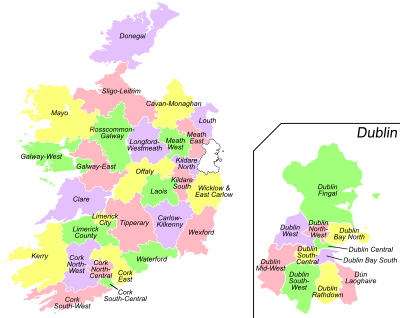Dáil constituencies
 |
|---|
| This article is part of a series on the politics and government of the Republic of Ireland |
|
Administrative geography |
|
|
There are currently 40 multi-member constituencies, that elect 158 TDs (members of parliament), to Dáil Éireann, Ireland's house of representatives, by means of the single transferable vote, to a maximum term of five years.
Electoral law
Article 16.2 of the Constitution of Ireland outlines the requirements for constituencies. The total number of TDs is to be no more than one TD representing twenty thousand and no less than one TD representing thirty thousand of the population, and the ratio should be the same in each constituency, as far as practicable, avoiding malapportionment . Constituencies are to be revised at least once in every twelve years in accordance with the census reports, which are compiled by the Central Statistics Office every five years; under the Electoral Act 1997, a Constituency Commission is to be established after each census.[1] The Commission is independent and is responsible for the redrawing of constituency boundaries.[2] Members of the five person commission must be a Judge of the Supreme Court, Court of Appeal or High Court as Chair, the Clerk of the Dáil, the Clerk of the Seanad, the Ombudsman, and the Secretary General of the Department of Housing, Planning and Local Government. Any alterations in the constituencies do not take effect during the life of the Dáil sitting when a revision is made.
The electoral system for general elections is proportional representation by means of a single transferable vote (PR-STV). Similarly, PR-STV is used in European Parliament elections, while by-elections (where this is only one vacancy) and presidential elections use alternative vote. The constitution specifies that the minimum number of TDs returned for each constituency is three, but does not define the maximum number; however, electoral law specifies a maximum number of five TDs.[3]
Current constituencies
For the 2016 general election, 158 TDs were elected from 40 constituencies. In June 2012 the Constituency Commission proposed changes to the constituencies to reduce the total number of TDs from 166 to 158 and the constituencies from 43 to 40.[4] The Electoral (Amendment) (Dáil Constituencies) Act 2013 provided for this change and for changes to constituencies.

| Constituency | Population [5] | Seats |
|---|---|---|
| Carlow–Kilkenny | 145,659 | 5 |
| Cavan–Monaghan | 120,483 | 4 |
| Clare | 111,336 | 4 |
| Cork East | 114,365 | 4 |
| Cork North-Central | 117,170 | 4 |
| Cork North-West | 86,593 | 3 |
| Cork South-Central | 117,952 | 4 |
| Cork South-West | 82,952 | 3 |
| Donegal | 152,358 | 5 |
| Dublin Bay North | 146,512 | 5 |
| Dublin Bay South | 116,396 | 4 |
| Dublin Central | 89,030 | 3 |
| Dublin Fingal | 141,162 | 5 |
| Dublin Mid-West | 110,427 | 4 |
| Dublin North-West | 90,534 | 3 |
| Dublin Rathdown | 87,470 | 3 |
| Dublin South-Central | 114,660 | 4 |
| Dublin South-West | 144,908 | 5 |
| Dublin West | 113,179 | 4 |
| Dún Laoghaire | 118,791 | 4 |
| Galway East | 89,564 | 3 |
| Galway West | 150,874 | 5 |
| Kerry | 145,502 | 5 |
| Kildare North | 115,350 | 4 |
| Kildare South | 59,162 | 3 |
| Laois | 87,745 | 3 |
| Limerick City | 113,835 | 4 |
| Limerick County | 83,834 | 3 |
| Longford–Westmeath | 116,802 | 4 |
| Louth | 143,272 | 5 |
| Mayo | 120,332 | 4 |
| Meath East | 86,572 | 3 |
| Meath West | 85,550 | 3 |
| Offaly | 87,640 | 3 |
| Roscommon–Galway | 84,586 | 3 |
| Sligo–Leitrim | 119,153 | 4 |
| Tipperary | 147,801 | 5 |
| Waterford | 113,795 | 4 |
| Wexford | 145,320 | 5 |
| Wicklow | 141,012 | 5 |
Constituencies at the next general election
The 2017 report of the Constituency Commission,[6] proposed several changes to Dáil constituencies. These changes were provided for by the Electoral (Amendment) (Dáil Constituencies) Act 2017, and will come into effect at the next general election, which is due by 12 April 2021 at the latest, but may take place before then. The total number of TDs will increase by two to 160, while the number of constituencies will be reduced by one to 39, as well as minor boundary revisions.
| Constituency | Seats |
|---|---|
| Carlow–Kilkenny | 5 |
| Cavan–Monaghan | 5 |
| Clare | 4 |
| Cork East | 4 |
| Cork North-Central | 4 |
| Cork North-West | 3 |
| Cork South-Central | 4 |
| Cork South-West | 3 |
| Donegal | 5 |
| Dublin Bay North | 5 |
| Dublin Bay South | 4 |
| Dublin Central | 4 |
| Dublin Fingal | 5 |
| Dublin Mid-West | 4 |
| Dublin North-West | 3 |
| Dublin Rathdown | 3 |
| Dublin South-Central | 4 |
| Dublin South-West | 5 |
| Dublin West | 4 |
| Dún Laoghaire | 4 |
| Galway East | 3 |
| Galway West | 5 |
| Kerry | 5 |
| Kildare North | 4 |
| Kildare South | 4 |
| Laois–Offaly | 5 |
| Limerick City | 4 |
| Limerick County | 3 |
| Longford–Westmeath | 4 |
| Louth | 5 |
| Mayo | 4 |
| Meath East | 3 |
| Meath West | 3 |
| Roscommon–Galway | 3 |
| Sligo–Leitrim | 4 |
| Tipperary | 5 |
| Waterford | 4 |
| Wexford | 5 |
| Wicklow | 5 |
Change in seats
This table summarises the changes in representation. It does not address revisions to the boundaries of constituencies.
| Constituency | Seats 2016 | Seats 2021 |
|---|---|---|
| Cavan–Monaghan | 4 | 5 |
| Dublin Central | 3 | 4 |
| Kildare South | 3 | 4 |
Constituencies abolished
| Constituency | Seats | Area now in |
|---|---|---|
| Laois | 3 | Laois–Offaly and Tipperary |
| Offaly | 3 | Laois–Offaly and Kildare South |
New constituencies
| Constituency | Seats | Area from |
|---|---|---|
| Laois–Offaly | 5 | Laois and Offaly |
References
- ↑ "Electoral Act 1997". Irish Statute Book. Retrieved 3 March 2016.
- ↑ Consultation Paper on the Establishment of an Electoral Commission in Ireland, (2015), Department of Environment, Community, and Local Government
- ↑ Electoral (Amendment) Act 2001, Office of the Attorney General
- ↑ "Summary of recommendation" (PDF). Constituency Commission. 21 June 2012.
- ↑ Collins, S, (2016), Election 2016; Constituency Profiles and Predictions, The Irish Times, Retrieved from http://www.irishtimes.com/election-2016/constituencies
- ↑ "Constituency Commission Report 2017" (PDF). Constituency Commission. 27 June 2017. Retrieved 29 January 2018.